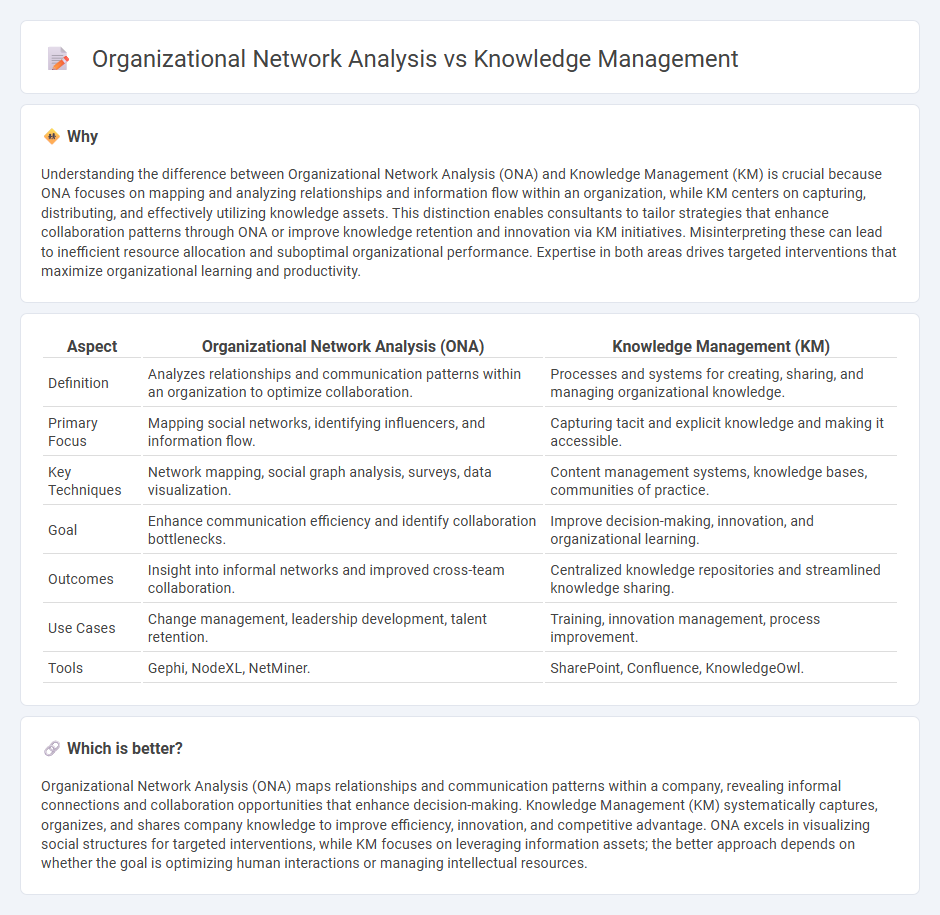
Organizational Network Analysis (ONA) maps relationships and communication patterns within a company to identify key influencers and collaboration bottlenecks, while Knowledge Management focuses on capturing, organizing, and sharing institutional knowledge to enhance decision-making and innovation. Integrating ONA with Knowledge Management strategies uncovers hidden expertise and optimizes knowledge flows, driving efficiency and competitive advantage. Explore how combining these approaches can transform your organizational performance.
Why it is important
Understanding the difference between Organizational Network Analysis (ONA) and Knowledge Management (KM) is crucial because ONA focuses on mapping and analyzing relationships and information flow within an organization, while KM centers on capturing, distributing, and effectively utilizing knowledge assets. This distinction enables consultants to tailor strategies that enhance collaboration patterns through ONA or improve knowledge retention and innovation via KM initiatives. Misinterpreting these can lead to inefficient resource allocation and suboptimal organizational performance. Expertise in both areas drives targeted interventions that maximize organizational learning and productivity.
Comparison Table
| Aspect | Organizational Network Analysis (ONA) | Knowledge Management (KM) |
|---|---|---|
| Definition | Analyzes relationships and communication patterns within an organization to optimize collaboration. | Processes and systems for creating, sharing, and managing organizational knowledge. |
| Primary Focus | Mapping social networks, identifying influencers, and information flow. | Capturing tacit and explicit knowledge and making it accessible. |
| Key Techniques | Network mapping, social graph analysis, surveys, data visualization. | Content management systems, knowledge bases, communities of practice. |
| Goal | Enhance communication efficiency and identify collaboration bottlenecks. | Improve decision-making, innovation, and organizational learning. |
| Outcomes | Insight into informal networks and improved cross-team collaboration. | Centralized knowledge repositories and streamlined knowledge sharing. |
| Use Cases | Change management, leadership development, talent retention. | Training, innovation management, process improvement. |
| Tools | Gephi, NodeXL, NetMiner. | SharePoint, Confluence, KnowledgeOwl. |
Which is better?
Organizational Network Analysis (ONA) maps relationships and communication patterns within a company, revealing informal connections and collaboration opportunities that enhance decision-making. Knowledge Management (KM) systematically captures, organizes, and shares company knowledge to improve efficiency, innovation, and competitive advantage. ONA excels in visualizing social structures for targeted interventions, while KM focuses on leveraging information assets; the better approach depends on whether the goal is optimizing human interactions or managing intellectual resources.
Connection
Organizational network analysis (ONA) maps and measures relationships and flows of information within an organization, providing insights into informal communication channels and collaboration patterns. Knowledge management leverages ONA to identify key knowledge holders, bridge knowledge silos, and optimize knowledge sharing processes across teams. Integrating ONA with knowledge management enhances organizational learning, innovation, and decision-making efficiency by aligning network structures with knowledge assets.
Key Terms
**Knowledge Management:**
Knowledge Management involves systematically capturing, organizing, and sharing an organization's intellectual assets to enhance decision-making and innovation. It emphasizes processes like knowledge creation, storage, retrieval, and transfer to improve overall performance and maintain competitive advantage. Explore further to understand how Knowledge Management strategies can transform organizational efficiency and collaboration.
Tacit Knowledge
Knowledge management emphasizes capturing, sharing, and leveraging tacit knowledge through practices like storytelling, mentorship, and communities of practice to enhance organizational learning and innovation. Organizational Network Analysis (ONA) uncovers informal communication patterns and social ties that facilitate the transfer of tacit knowledge across employees and units, revealing hidden influencers and knowledge hubs. Explore how integrating knowledge management and ONA strategies can optimize tacit knowledge flow within your organization.
Knowledge Sharing
Knowledge management emphasizes structured processes and technologies to facilitate knowledge capture, storage, and sharing within an organization. Organizational network analysis maps informal relationships and communication patterns to identify key knowledge hubs and bottlenecks impacting knowledge sharing. Explore how combining these approaches enhances the effectiveness of knowledge transfer in your organization.
Source and External Links
What Is Knowledge Management? - IBM - Knowledge management (KM) is the process of identifying, organizing, storing, and disseminating information within an organization to improve operational efficiencies and decision-making, supported often by knowledge management systems that centralize access to knowledge.
What is Knowledge Management? A Complete Guide - Bloomfire - KM is a systematic approach to capturing, organizing, and leveraging organizational knowledge to facilitate decision-making, improve efficiency, promote innovation, enhance collaboration, preserve institutional knowledge, and support employee learning and development.
What is Knowledge Management? The Complete Guide - Salesforce - Knowledge management involves creating, organizing, sharing, and using knowledge within an organization to improve efficiency, reduce training time, enhance service quality, and maintain up-to-date information accessible to employees, customers, and agents.
 dowidth.com
dowidth.com